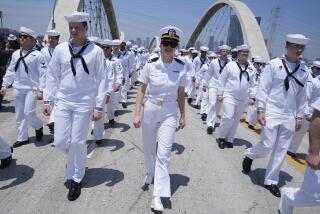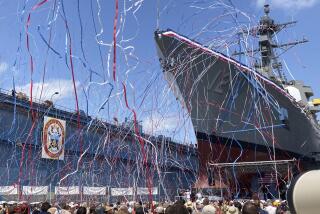Witness to History : Ward Munson Stood for Those Who Had Fallen as Ceremony Ended WWII
- Share via
FULLERTON — By his account, 85-year-old Ward Munson has led a fairly ordinary life.
But for one extraordinary moment almost 50 years ago, Munson--then a U.S. Navy lieutenant--stood on the deck of the battleship USS Missouri in Tokyo Bay and watched as Gen. Douglas MacArthur and Fleet Adm. Chester W. Nimitz met Japanese dignitaries for the official surrender ceremonies ending World War II.
“When it was announced that the Japanese delegation was aboard there was a dead silence and all you could hear was the sound of [Japanese Foreign Minister Mamoru] Shigametzu’s wooden leg as he climbed the plank and came aboard,” recalled Munson.
On Sept. 2, 1945, it was Munson’s job as a member of the small protocol committee to make sure the ceremony went off without a hitch and that all in the large assemblage--from admirals and generals and Japanese officials down to the lowliest sailor--were standing in the proper place for the historic peace signing.
“I realized that I was no hero and had done nothing to deserve this honor to be there at the time of the signing of the peace and to have a hand in organizing the ceremony,” Munson said Thursday. “But, I thought of all of those who had given their lives and I felt that I was standing in for them.”
Munson was a longtime Corona del Mar resident before moving to the Morningside retirement community in Fullerton this year. His wife, Alice, died last year. He has three children and eight grandchildren.
The retired founder of a successful sporting goods company, Munson has also spent the last five decades collecting wartime memorabilia, including vintage photographs he donated to the now-decommissioned Missouri.
As the 50th anniversary of the official end of the war draws near, Munson, who keeps fit by playing tennis, is keeping a breakneck schedule.
He has accepted numerous speaking engagements where he effortlessly recalls the details of a remarkable time for audiences of all ages, many of whom know little of the war that embroiled the whole world and claimed an estimated 50 million lives.
“You speak to children and they sit there with a blank look on their face,” Munson said, chuckling. “But you can’t expect the children to be as interested as those of us who lived through it.”
Munson said his two years in the Navy, which began with a short stint on Nimitz’s ship in Pearl Harbor in 1943, were filled with adventure and peril, especially after he convinced his superiors to transfer him to the Missouri in November, 1944.
*
“Being in Pearl Harbor was the best duty in the world because you knew what was going on and it was safe,” he said. “But I didn’t join the Navy to be safe and have a great time so I asked to be put on the new battleship.”
The Missouri was the last battleship built by the United States. It was equipped with nine 16-inch guns that could hurl 2,700-pound, armor-piercing shells more than 20 miles.
The ship, which survived a kamikaze attack off Okinawa, joined the three sister ships in its class--the Iowa, the New Jersey and the Wisconsin--in some of the closing battles of World War II.
“It was exciting and interesting but also kind of scary,” Munson said. “And you were always tired.”
After completing operations off Okinawa and Iwo Jima, the Missouri was preparing for the planned invasion of Japan’s home islands in the fall of 1945 when the atomic bombs dropped on Hiroshima and Nagasaki brought an end to the war.
“We were ecstatic with joy,” Munson recalled. “Everyone wanted to get the war over with and get home to our families. But we also knew that the dropping of the bomb was going to change the world, as it has.”
Still, there were anxious moments even up until the shipboard ceremonies.
“We were the first American ship to enter Tokyo Bay. But we followed a Japanese destroyer because if the bay had not been cleared of mines, the destroyer would be blown up first,” Munson recounted. “There were guns pointed at us and you could see the Japanese soldiers running around. You had to think to yourself, ‘I’m sure they got the word.’ ”
Once the ship was anchored, one of the first decisions to be made was what uniform the sailors would wear for the surrender. At first, an order was issued that they would all wear their dress whites for the signing.
*
“But Adm. Nimitz said it would not be dress whites, but instead it would be khakis. He said, ‘We’ll meet the enemy in the same uniform that we wore to win the war.’ ”
The young lieutenant said he watched with awe as the enemy’s military leaders boarded the ship and then signed a series of documents. He said he grew emotional when five-star general MacArthur beckoned American Lt. Gen. Jonathan M. Wainwright and British Lt. Gen. Arthur Percival to stand behind him as he signed on behalf of the Allied powers.
“[Wainwright and Percival] had just been rescued from a prison camp where they had been for over three years,” Munson said. “They were so emaciated that their uniforms just hung on them. But, with the first pen Gen. MacArthur used, he turned and handed it to Gen. Wainwright and the second pen to Gen. Percival. Those of us who were close enough to see this had tears in our eyes.”
As this was going on, Munson said, he began to think of soldiers who had lost their lives on the beach assaults of the South Pacific. He said he thought of pilots shot out of the sky and sailors who went down with their ships.
“My personal thoughts were shattered by a tremendous roar,” he said, his eyes closed. “I looked up and there were 1,900 Allied planes, mostly American, flying over the Missouri, wave after wave. And at that point, the sky opened up--really for the first time that day--and I thought, ‘God is looking down and blessing this ceremony today.’ ”
He will return to the deck of the famed battleship in Bremerton, Wash., next week for a ceremony commemorating the end of the war.
More to Read
Sign up for Essential California
The most important California stories and recommendations in your inbox every morning.
You may occasionally receive promotional content from the Los Angeles Times.













